PPT在英语教学中的应用
- 格式:doc
- 大小:30.00 KB
- 文档页数:2
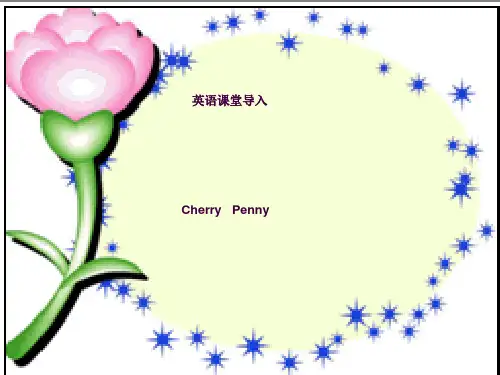
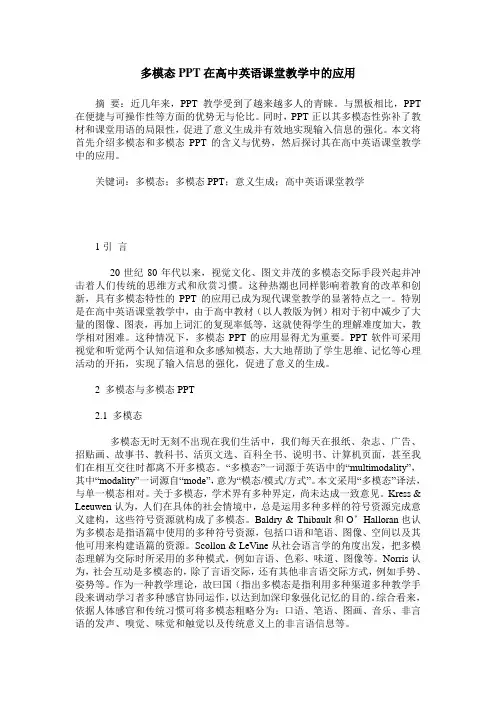
多模态PPT在高中英语课堂教学中的应用摘要:近几年来,PPT教学受到了越来越多人的青睐。
与黑板相比,PPT 在便捷与可操作性等方面的优势无与伦比。
同时,PPT正以其多模态性弥补了教材和课堂用语的局限性,促进了意义生成并有效地实现输入信息的强化。
本文将首先介绍多模态和多模态PPT的含义与优势,然后探讨其在高中英语课堂教学中的应用。
关键词:多模态;多模态PPT;意义生成;高中英语课堂教学1引言20世纪80年代以来,视觉文化、图文并茂的多模态交际手段兴起并冲击着人们传统的思维方式和欣赏习惯。
这种热潮也同样影响着教育的改革和创新,具有多模态特性的PPT的应用已成为现代课堂教学的显著特点之一。
特别是在高中英语课堂教学中,由于高中教材(以人教版为例)相对于初中减少了大量的图像、图表,再加上词汇的复现率低等,这就使得学生的理解难度加大,教学相对困难。
这种情况下,多模态PPT的应用显得尤为重要。
PPT软件可采用视觉和听觉两个认知信道和众多感知模态,大大地帮助了学生思维、记忆等心理活动的开拓,实现了输入信息的强化,促进了意义的生成。
2 多模态与多模态PPT2.1 多模态多模态无时无刻不出现在我们生活中,我们每天在报纸、杂志、广告、招贴画、故事书、教科书、活页文选、百科全书、说明书、计算机页面,甚至我们在相互交往时都离不开多模态。
“多模态”一词源于英语中的“multimodality”,其中“modality”一词源自“mode”,意为“模态/模式/方式”。
本文采用“多模态”译法,与单一模态相对。
关于多模态,学术界有多种界定,尚未达成一致意见。
Kress & Leeuwen认为,人们在具体的社会情境中,总是运用多种多样的符号资源完成意义建构,这些符号资源就构成了多模态。
Baldry & Thibault和O’Halloran也认为多模态是指语篇中使用的多种符号资源,包括口语和笔语、图像、空间以及其他可用来构建语篇的资源。
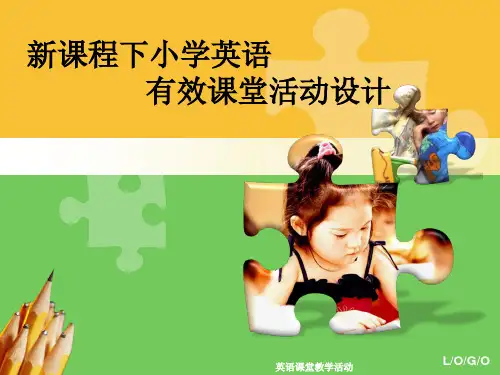
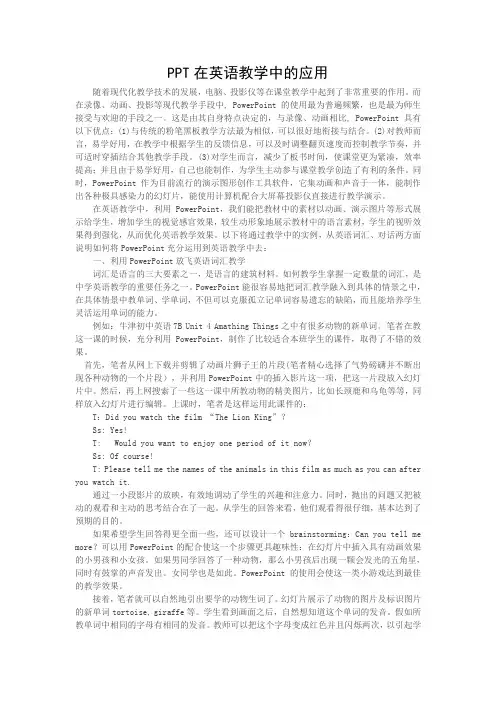
PPT在英语教学中的应用随着现代化教学技术的发展,电脑、投影仪等在课堂教学中起到了非常重要的作用。
而在录像、动画、投影等现代教学手段中, PowerPoint的使用最为普遍频繁,也是最为师生接受与欢迎的手段之一。
这是由其自身特点决定的,与录像、动画相比, PowerPoint具有以下优点:(1)与传统的粉笔黑板教学方法最为相似,可以很好地衔接与结合。
(2)对教师而言,易学好用,在教学中根据学生的反馈信息,可以及时调整翻页速度而控制教学节奏,并可适时穿插结合其他教学手段。
(3)对学生而言,减少了板书时间,使课堂更为紧凑,效率提高;并且由于易学好用,自己也能制作,为学生主动参与课堂教学创造了有利的条件。
同时,PowerPoint作为目前流行的演示图形创作工具软件,它集动画和声音于一体,能制作出各种极具感染力的幻灯片,能使用计算机配合大屏幕投影仪直接进行教学演示。
在英语教学中,利用PowerPoint,我们能把教材中的素材以动画、演示图片等形式展示给学生,增加学生的视觉感官效果,较生动形象地展示教材中的语言素材,学生的视听效果得到强化,从而优化英语教学效果。
以下将通过教学中的实例,从英语词汇、对话两方面说明如何将PowerPoint充分运用到英语教学中去:一、利用PowerPoint放飞英语词汇教学词汇是语言的三大要素之一,是语言的建筑材料。
如何教学生掌握一定数量的词汇,是中学英语教学的重要任务之一。
PowerPoint能很容易地把词汇教学融入到具体的情景之中,在具体情景中教单词、学单词,不但可以克服孤立记单词容易遗忘的缺陷,而且能培养学生灵活运用单词的能力。
例如:牛津初中英语7B Unit 4 Amathing Things之中有很多动物的新单词。
笔者在教这一课的时候,充分利用PowerPoint,制作了比较适合本班学生的课件,取得了不错的效果。
首先,笔者从网上下载并剪辑了动画片狮子王的片段(笔者精心选择了气势磅礴并不断出现各种动物的一个片段),并利用PowerPoint中的插入影片这一项,把这一片段放入幻灯片中。
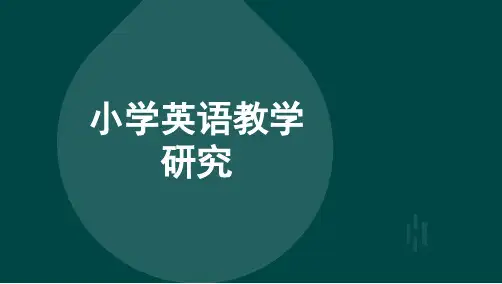
考试结构“识记”为20%50%30%。
考试方式150 60考试技巧1VS 231234考试方法123456绪论重点重点重点难点第十一章第十二章各章要点,,应用,谢谢本章考点归纳考点1考点2 及方法考点3绪论考点1小学英语教学的意义及目的考点1小学英语教学的意义及目的例题正确答案:考点2研究和学习小学英语教学法的意义及方法例题正确答案:考点3小学英语教学法中的语言观、学习观、教育观、哲学观1234考点3小学英语教学法中的语言观、学习观、教育观、哲学观学习动机,心理素质及个人学习方法。
考点3小学英语教学法中的语言观、学习观、教育观、哲学观考点3小学英语教学法中的语言观、学习观、教育观、哲学观例题。
正确答案:谢谢本章考点归纳考点1考点2考点3小学考点1小学英语教学的特点一、儿童语言习得的理论1.(1(22.3.4.5.考点1小学英语教学的特点二、儿童的外语学习1.(1(22.(1(2(3(4考点1小学英语教学的特点二、儿童的外语学习例题正确答案:(1(2(3(4例题正确答案:考点2 小学英语教学的基本原则例题正确答案:考点3 小学英语教学的目标与要求(如涂)帮考点3 小学英语教学的目标与要求考点3 小学英语教学的目标与要求1.级别技能一级听做1234说唱123456、15-2015一20首;7玩演123读写1234视听121020-25级别技能二级听1234说1234、读123456写1234玩演视听12330-40430-40首51020-25考点3 小学英语教学的目标与要求2.考点3 小学英语教学的目标与要求3.考点3 小学英语教学的目标与要求4.考点3 小学英语教学的目标与要求5.例题、、、。
正确答案:谢谢本章考点归纳考点1考点2考点1外国教学法主要流派简介六、TPR考点1外国教学法主要流派简介(1(2(3(4(5(6考点1外国教学法主要流派简介(1(2(3(4考点1外国教学法主要流派简介(5(6(7。
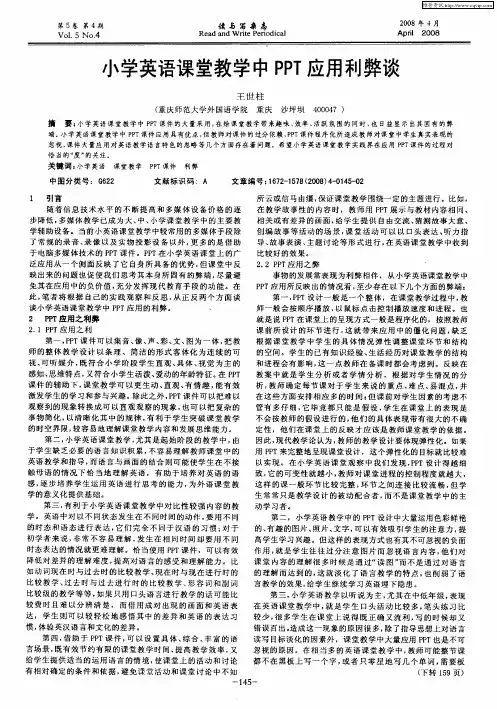

ppt在课堂上的使用越来越流行英语作文PPT is becoming more and more popular in classroom teaching. There are several reasons for this trend.First of all, PPT is a visual aid that can help students better understand complex concepts. It provides a clear and organized way to present information, making it easier for students to follow along and grasp the key points.Secondly, PPT allows for interactive and engaging presentations. Teachers can include multimedia elements such as images, videos, and animations to make the lesson more dynamic and interesting. This can capture students' attention and keep them focused on the lesson.Furthermore, PPT can save time and effort for both teachers and students. Teachers can prepare their presentations in advance and easily share them with students. Students can also access the slides later for review and revision.In addition, PPT can promote collaboration and communication in the classroom. Teachers can use PPT to facilitate group discussions, brainstorming sessions, andinteractive activities. This can encourage students to participate actively and work together towards a common goal.Overall, the use of PPT in the classroom has many benefits and is a valuable tool for both teachers and students. It enhances learning outcomes, promotes engagement, and facilitates communication. As technology continues to advance, PPT will likely remain a popular and effective teaching tool in the future.PPT在课堂上的使用越来越流行。
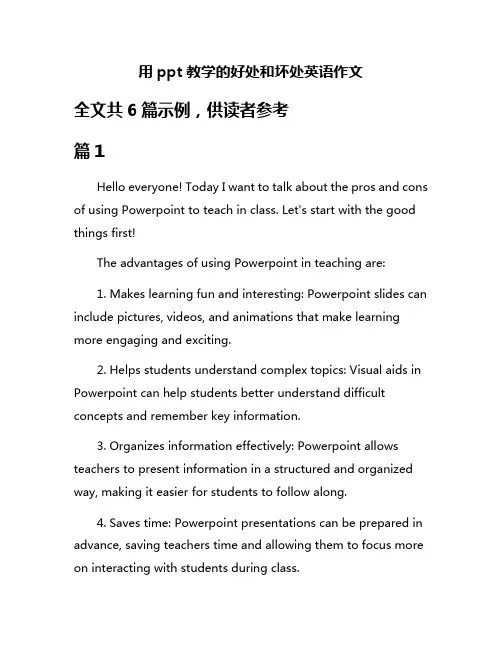
用ppt教学的好处和坏处英语作文全文共6篇示例,供读者参考篇1Hello everyone! Today I want to talk about the pros and cons of using Powerpoint to teach in class. Let's start with the good things first!The advantages of using Powerpoint in teaching are:1. Makes learning fun and interesting: Powerpoint slides can include pictures, videos, and animations that make learning more engaging and exciting.2. Helps students understand complex topics: Visual aids in Powerpoint can help students better understand difficult concepts and remember key information.3. Organizes information effectively: Powerpoint allows teachers to present information in a structured and organized way, making it easier for students to follow along.4. Saves time: Powerpoint presentations can be prepared in advance, saving teachers time and allowing them to focus more on interacting with students during class.Now, let's talk about the disadvantages of using Powerpoint:1. Can be boring: Sometimes, staring at a screen full of text and images for a long time can be dull and monotonous for students.2. Over-reliance on technology: If the Powerpoint presentation fails or technical issues arise, it can disrupt the flow of the lesson and create challenges for the teacher.3. Limits creativity: Teachers may feel restricted by the format of Powerpoint and miss out on opportunities to explore more creative teaching methods.In conclusion, while Powerpoint can be a useful tool in teaching, it is important to use it thoughtfully and in moderation. Mixing in other teaching methods and activities can keep students engaged and help them learn more effectively. Thank you for listening!篇2PPT is a great tool for teachers to use in the classroom. There are lots of advantages to using PPT and some disadvantages too.The good things about PPT are that it can make lessons more fun and interesting. The pictures and videos can help usunderstand difficult topics better. It's also a good way to keep our attention because it's always changing. PPT can also help us remember things better as we can see the information in a visual way.But there are also some bad things about PPT. Sometimes the slides can be too busy and hard to read. And if the teacher relies too much on PPT, they might forget to interact with us and answer our questions. PPT can also be a distraction if we start looking at other things on the screen instead of listening to the teacher.Overall, PPT can be a really useful tool in the classroom if it's used in the right way. It's important for teachers to make sure the slides are clear and easy to understand, and to still interact with us during the lesson. So next time your teacher brings out the PPT, remember all the good things it can bring to the lesson!篇3Hello everyone! Today I want to talk about the pros and cons of using PowerPoint presentations in class. As we all know, PowerPoint is a popular tool for teachers to make their lessons more interactive and engaging. But is it always a good thing?Let's start with the good stuff. One of the biggest benefits of using PowerPoint is that it makes the lesson more visually appealing. Instead of just listening to the teacher talk, we get to see pictures, videos, and animations that help us understand the material better. It also helps us stay focused and interested in the lesson, instead of getting bored and distracted.Another advantage of using PowerPoint is that it can make complex information easier to understand. By breaking down the content into smaller chunks and using bullet points, charts, and graphs, the teacher can make it easier for us to digest the information and remember it later.Furthermore, PowerPoint allows teachers to easily share their lesson materials with us. They can upload their presentations online or send them to our email, so we can review the material at home or study for a test.However, there are also some downsides to using PowerPoint in class. One of the biggest drawbacks is that it can be too passive. Instead of actively participating in the lesson, we might just sit back and watch the slides go by. This could lead to us not fully understanding the material or not asking questions if we are confused.Another disadvantage is that some teachers rely too heavily on PowerPoint and forget to engage with us in other ways. They might just read off the slides without adding any extra explanations or examples, which can make the lesson boring and uninteresting.In conclusion, while PowerPoint can be a useful tool for enhancing our learning experience, it's important for teachers to use it in moderation and supplement it with other teaching methods. By combining PowerPoint with discussions, group activities, and hands-on experiments, we can get the most out of our education. Thank you for listening, and I hope you learned something new today!篇4Title: The Pros and Cons of Using PowerPoint for TeachingHey everyone! Today, I want to talk about using PowerPoint for teaching. It's something we see a lot in school, but is it always a good thing? Let's find out!First, let's talk about the good stuff. PowerPoint can make learning more fun and interactive. The slides can have pictures, videos, and animations that help us understand the topic better. It's like watching a movie in class!Also, PowerPoint is great for organizing information. The slides have bullet points and headings that make it easy to follow along. We can also take notes on the slides, which helps us remember the important stuff.Another cool thing about PowerPoint is that we can share our presentations with others. We can send them to our friends or even upload them online for everyone to see. It's like becoming a mini teacher!But, there are also some not-so-great things about PowerPoint. Sometimes, teachers rely too much on the slides and forget to engage with us students. It can feel like we're just reading off a screen instead of having a real conversation.Also, some teachers use too many words on the slides. It can be overwhelming and boring to read all that text. We want to see more pictures and videos, not a whole book on the screen!And finally, PowerPoint can be a distraction. We might get so caught up in the fancy animations and designs that we forget to pay attention to the actual lesson. It's like watching a movie when we should be studying!So, in conclusion, PowerPoint can be a great tool for teaching, but it's important to use it wisely. Let's keep things funand interactive, but also remember to engage with each other and focus on the lesson. Who knew a simple slideshow could have so much impact on our learning? Let's make the most of it!篇5Title: The Pros and Cons of Using PowerPoint for TeachingHey guys, today we're going to talk about the good things and not so good things about using PowerPoint for teaching. Let's get started!The good things about using PowerPoint are:1. Visual Aids: PowerPoint helps us to use pictures, diagrams, and charts to make our lessons more interesting and easier to understand.2. Organization: With PowerPoint, we can organize our information in a clear and structured way, making it easier for us and our classmates to follow along.3. Engagement: PowerPoint can be interactive with animations, transitions, and quizzes, making learning more fun and engaging.4. Accessibility: PowerPoint can be easily shared online or through email, allowing us to revisit the lesson anytime and anywhere.However, there are also some not so good things about using PowerPoint:1. Dependency: Sometimes we rely too much on PowerPoint and forget to engage with our classmates through discussions, activities, and experiments.2. Distraction: Too many slides, animations, and colors can be overwhelming and distracting, making it hard for us to focus on the key points.3. Passive Learning: Watching a presentation can be passive, and we may not retain as much information compared to hands-on learning experiences.4. Technical Issues: Sometimes PowerPoint can crash, the projector may not work, or the internet connection may fail, causing disruptions to our lesson.In conclusion, PowerPoint is a great tool for teaching, but we should use it responsibly and balance it with other teaching methods to create a well-rounded learning experience. Thanks for listening, and see you next time!篇6Hello everyone! Today, I want to talk about the advantages and disadvantages of using PowerPoint for teaching.Let's start with the good stuff. PowerPoint is super cool because you can make your presentation look really nice and colorful. You can add pictures, charts, and even videos to help explain your lesson. It can make learning more fun and interesting for us students.Another awesome thing about using PowerPoint is that it helps the teacher stay organized. They can plan out their lesson with slides in advance and make sure they cover all the important points. This way, they won't forget anything and we can learn everything we need to know.But, like everything else, PowerPoint has its downsides too. Sometimes, the teacher might rely too much on the slides and forget to explain things in more detail. This can make it hard for us to understand the lesson fully. Also, if the teacher has a lot of text on the slides, it can be boring for us to read and listen at the same time.Another disadvantage is that if the teacher's computer or the projector breaks down, then the whole lesson could be ruined.We would have to wait for it to get fixed and that can waste a lot of our learning time.In conclusion, using PowerPoint for teaching has its pros and cons. It can make learning more fun and organized, but it can also be a bit boring and unreliable. So, teachers should try to use it wisely and not overdo it. That way, we can all have a great time learning in school!Thank you for listening!。

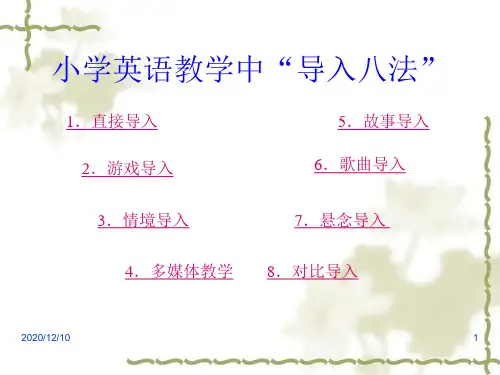
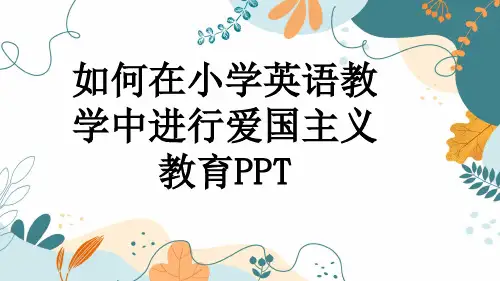
小学英语交际法教学案例PPT交际教学法(交际法)又称功能法(Functional Method)或意念法,由英国语言学家威尔金斯(John Wilkins)于20世纪70年代创立。
这是一种重视语言交际功能的教学法,强调培养学习者应用语言进行交往的能力。
交际法的产生源于现实发展的需要。
20世纪70年代初,挨过了第二次世界大战的西欧各国迫切需要恢复战前的经济盛况。
西欧经济发展的巨大潜力吸引了大量的移民,但是语言不通成为他们的一大难题,他们迫切需要掌握外语进行交往。
与此同时,欧洲各国之间的交往日益密切,迫切需要能进行深入沟通的高层次外语人才。
在这种需求的推动下,1971年,范·埃克出版了《入门阶段》;随后,威尔金斯(John Wilkins)出版了《意念大纲》一书,这代表着交际法的诞生。
与传统的以语法学习为纲的方法不同,交际法依据语言的意义和功能范畴来安排语言学习,这种方法迎合了社会对短期内培养能用外语进行交往的人才的迫切需求,因此得到了广泛传播。
1.交际法的语言观交际法的产生是为了满足人们对于短期内学习外语进行交往的需要,因此交际法十分注重语言的实际效用。
围绕着语言的功能,着力于培养使用语言的交际能力,形成了一整套完整的教学方法体系。
它认为教学应以语言功能为主,教学过程应该是学习使用语言的过程,即交际过程,教学的最终目的是帮助学习者学会在不同的场合、对不同的对象、用目的语进行流利的交际。
总体来说,交际法的基本概念为“意念”“功能”与“交际”。
意念与认知有关,指的是人们由事物所引发的思想、观点;功能指语言用以叙述事情和表达思想的作用;交际则是运用语言的过程和结果。
语言的功能和意念在语言交际过程中是紧密联系的,例如,询问学校的距离:“Is the school far away from here?”询问是功能,学校和距离是意念。
2.交际法的步骤在实际的教学活动中,交际法常用的教学模式大致包括热身、创设情境、呈现新语料和操练等几个步骤。
PPT在英语教学中的应用
随着现代化教学技术的发展,电脑、投影仪等在课堂教学中起到了非常重要的作用。
而在录像、动画、投影等现代教学手段中, PowerPoint的使用最为普遍频繁,也是最为师生接受与欢迎的手段之一。
这是由其自身特点决定的,与录像、动画相比, PowerPoint具有以下优点:(1)与传统的粉笔黑板教学方法最为相似,可以很好地衔接与结合。
(2)对教师而言,易学好用,在教学中根据学生的反馈信息,可以及时调整翻页速度而控制教学节奏,并可适时穿插结合其他教学手段。
(3)对学生而言,减少了板书时间,使课堂更为紧凑,效率提高;并且由于易学好用,自己也能制作,为学生主动参与课堂教学创造了有利的条件。
同时,PowerPoint作为目前流行的演示图形创作工具软件,它集动画和声音于一体,能制作出各种极具感染力的幻灯片,能使用计算机配合大屏幕投影仪直接进行教学演示。
在英语教学中,利用PowerPoint,我们能把教材中的素材以动画、演示图片等形式展示给学生,增加学生的视觉感官效果,较生动形象地展示教材中的语言素材,学生的视听效果得到强化,从而优化英语教学效果。
以下将通过教学中的实例,从英语词汇、对话两方面说明如何将PowerPoint充分运用到英语教学中去:
一、利用PowerPoint放飞英语词汇教学
词汇是语言的三大要素之一,是语言的建筑材料。
如何教学生掌握一定数量的词汇,是中学英语教学的重要任务之一。
PowerPoint能很容易地把词汇教学融入到具体的情景之中,在具体情景中教单词、学单词,不但可以克服孤立记单词容易遗忘的缺陷,而且能培养学生灵活运用单词的能力。
例如:牛津初中英语7B Unit 4 Amathing Things之中有很多动物的新单词。
笔者在教这一课的时候,充分利用PowerPoint,制作了比较适合本班学生的课件,取得了不错的效果。
首先,笔者从网上下载并剪辑了动画片狮子王的片段(笔者精心选择了气势磅礴并不断出现各种动物的一个片段),并利用PowerPoint中的插入影片这一项,把这一片段放入幻灯片中。
然后,再上网搜索了一些这一课中所教动物的精美图片,比如长颈鹿和乌龟等等,同样放入幻灯片进行编辑。
上课时,笔者是这样运用此课件的:
T:Did you watch the film “The Lion King”?
Ss: Yes!
T: Would you want to enjoy one period of it now?
Ss: Of course!
T: Please tell me the names of the animals in this film as much as you can after you watch it.
通过一小段影片的放映,有效地调动了学生的兴趣和注意力。
同时,抛出的问题又把被动的观看和主动的思考结合在了一起。
从学生的回答来看,他们观看得很仔细,基本达到了预期的目的。
如果希望学生回答得更全面一些,还可以设计一个brainstorming:Can you tell me more?可以用PowerPoint的配合使这一个步骤更具趣味性:在幻灯片中插入具有动画效果的小男孩和小女孩。
如果男同学回答了一种动物,那么小男孩后出现一颗会发光的五角星,同时有鼓掌的声音发出。
女同学也是如此。
PowerPoint的使用会使这一类小游戏达到最佳的教学效果。
接着,笔者就可以自然地引出要学的动物生词了。
幻灯片展示了动物的图片及标识图片的新单词tortoise, giraffe等。
学生看到画面之后,自然想知道这个单词的发音。
假如所教单词中相同的字母有相同的发音。
教师可以把这个字母变成红色并且闪烁两次,以引起学
生的注意。
众所周知,如果既能听到又能看到,再通过讨论、交流,用自己的语言表达出来,知识的保持将大大优于传统教学的效果。
用PowerPoint来教词汇能很艺术地复习、拓展和强化词汇,同时还能使词汇的意义和用法的教学、词汇的读音和拼写的教学紧密结合起来,使学生学习英语词的读音和书写形式时,不感到杂乱,而感到有条理、有规律,从而调动学生学习英语的积极性并巩固记忆。
二、利用PowerPoint放飞英语对话教学
学习英语是为了用英语与人交际,而不是仅为向人炫耀自己已学了多少英语知识。
英语新教材就是以“结构——功能”体系为主旨编写的。
所以,作为学生学习英语的指导者,在中学英语教学中优先注重交际能力的培养。
在教学过程中,应通过自然交际展示新的语言材料,创造情景让学生进行课堂交际活动,达到学生能运用所学进行简单交流的目的。
而英语学习所需的大量的语言环境,都可以通过优选的图文、声音、语言环境在PowerPoint中充分创造。
例如:牛津初中英语 7B Unit 3 Finding Your Way这一单元的学习目标之一就是引入有关地点和交通的话题,学会给别人指路,能对他人指引的路线做出正确的反映。
第一,笔者利用PowerPoint中的绘图功能在模板中画了彩色的方向图标,并且设定了东南西北、西北、西南等依次出现。
还从网上找了八幅可爱的图片,分别是hospital,restaurant,shopping mall等,让他们对应出现在方向图标上。
这样就可以让学生在复习八个新单词north,south,southwest…的基础上充分操练“A is north / south / northwest…of B”这一句型。
第二,笔者把课文第49页的地图插入PowerPoint中的模板,先让学生找到Where are Sunshine Town Railway Station and Sunnyside Shopping Mall?然后让学生思考:How can I get to Sunshine Town Railway Station from Sunnyside Shopping Mall?在充分开动学生脑筋的基础上引入Neil和Simon的对话。
第三,笔者把采用电脑制作的地图和动画片放入PowerPoint的模板中。
图中分别有:hospital,bookshop,station,park等组织学生进行替换练习,操练句型。
“which is the way to…/Can you tell me the way to …/Can you tell me how to get to…?”然后,通过放映动画片使学生反复运用walk/go?along,take…turning?on?the?right/left,turn?left/right,Walk straight? on? until you? reach? the?…等来指路。
最后,巩固一堂课所学的内容。
笔者并没有完成最后一张模板,而是仅仅在正中画了大街,在边上放了一些小的post office,local theatre,bridge,traffic lights 等图片。
笔者让学生自己来设计地图,并让他们表达。
学生第一次能用教师的计算机在班上操作,并且此形式比较生动,学生热情很高。
学生学习语言不是孤立的,而是能在不同的语言情境中进行交际。
笔者运用PowerPoint 贴近日常学习、生活情景组织课堂对话教学,给学生说的机会,让学生在有声有色的语言环境中,积极主动地参与学习和运用。
这样,学生就有了运用英语进行听说读写、交流信息和思想感情的能力。
教师如果很好地运用PowerPoint能将抽象的知识想象化、具体化,将教学内容与学生有机地结合起来,达到声、画交融,给学生创造交际的氛围,加强语言信息刺激,引发学生思维的欲望。
教师运用PowerPoint创造和利用情景组织课堂教学,使得教学内容更生动,使学生身临其境,学得轻松愉快,从而突出重点,突破难点,易于学生掌握,从而提高了他们使用英语的能力。